Ayam buah keluak is a very traditional chicken curry that owes its origin to the Nyonya community in Malacca. However, something that not many people know, is that the Portuguese Eurasians in this city have also long been cooking this highly aromatic dish.
Estimated reading time: 13 minutes
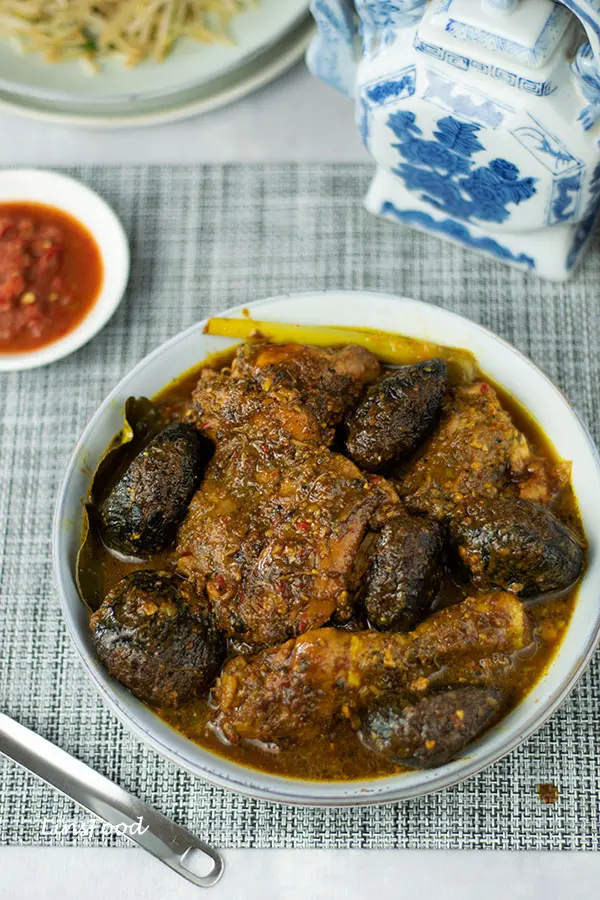
What is Ayam Buah Keluak?
Let’s take a look at the name first, shall we?
- Ayam = chicken
- Buah keluak = refers to the seeds of the pangium edule fruit (buah means fruit)
Ayam buah keluak is like a cross between a dry stew and a curry. There are so many dishes in South East Asia that are not actually curries but what else are you going to call them? Like Ayam Masak Kicap.
So for simplicity, let’s call it a curry. Of sorts.
The dish itself is made up of chicken and buak keluak, the aforementioned seeds, cooked with a highly aromatic spice paste which is homemade, naturally.
What does it Taste Like?
It’s very aromatic, like many Nyonya curries, given the use of herbs and spices like lemongrass, galangal, candlenuts and shrimp paste. On top of that, we use a fair amount of tamarind, giving our ayam buah keluak a slightly sour flavour as well.
Is ayam buah keluak spicy? It’s mildly spicy, as we only use a small amount of chillies in the recipe.
What is Buah Keluak?
As mentioned above, they are the seeds of the pangium edule fruit. The tree grows to a massive height and is native to many parts of South East Asia.
The use of buah keluak for culinary purposes is said to have come from the Indonesians. Rawon, a darkly coloured beef soup is a classic example of how buah keluak is used.
Also known as kepayang in some parts of Malaysia, buak keluak has the rather infamous distinction of being poisonous as it contains hydrocyanic acid (hydrogen cyanide). In fact, even the leaves and bark of the kepayang tree are believed to contain cyanide.
For this reason, the seeds are traditionally buried in volcanic ash for 40 days to help get rid of the cyanide. It is only then that they are sold for consumption.
But the seeds still need to be soaked for a few days and scrubbed meticulously to get rid the layer of ash, as the whole thing is then thrown into our ayam buah keluak.
Look out for my next article, where I’ll look into slightly further detail about this dubious nut!
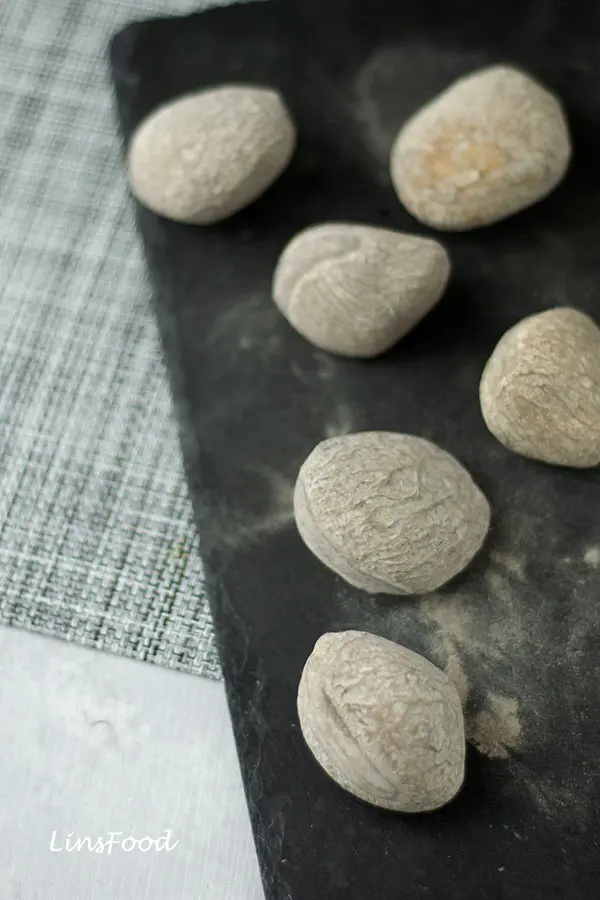
What does Buah Keluak Taste Like?
Buah keluak, to me, is earthy, a little pungent and with strong bitter undertones akin to cacao beans with hints of smokiness. That last characteristic could be as a result of being buried in ash for a long time.
Some chefs liken it to black truffle hence the moniker black diamond of Peranakan cuisine. Others call it black gold.
Whatever its nickname, one thing’s for sure, for many, buak keluak is an acquired taste. I introduced today’s dish to the family on our last trip to Malacca. My late husband wasn’t too keen, but my kids, who hadn’t gone vegetarian at that point, absolutely loved it.
Where to get Buak Keluak?
This is probably going to be your biggest challenge, depending on where you live. I’ve been in the UK for almost 30 years, and it’s only in the last 15 years or so that I’ve been able to get my hands on them. Occasionally.
Before that, I’d get them via visiting family and friends from Singapore or Malaysia.
This latest batch was bought online from a now closed Indonesian retailer. Just do a Google search while keeping your fingers crossed!
Ayam Buah Keluak Recipe
Cooking ayam buah keluak at home is very, very doable. The recipe has a reputation of being laborious and I read many comments of how tedious and difficult it is.
Comments like “it takes days to cook”, or “the prep work takes days”, are just ridiculous. Yes, we soak buah keluak for 5 days before using, but that’s just literally, dumping them in a large bowl, filling them with water and cover. That takes 2 minutes?
As far as I’m concerned, the soaking doesn’t get taken into account. I do it while my tea is brewing in the mornings, which takes 4 minutes.
It’s like saying dal or chickpeas take 2 days to cook because we soak them overnight!
A Recipe for Occasions
The bottom line is, it’s a recipe for special occasions. Or the weekends. For many Nyonya families, ayam buah keluak is a must at Chinese New Year, and the same goes for many Portuguese Eurasians in Malacca, alongside Curry Devil and Feng.
I tend to cook it a couple of times a year, for no particular reason, other than I miss it. It’s not a recipe I teach in my classes because I can’t always guarantee that I’ll find buah keluak when I need it.
But it’s definitely something I reserve for weekends or when having friends over.
Now every family is going to have its own way of cooking this Nyonya dish. Some use more buah keluak than others, while some make it a little spicier.
The Peranakan recipe stuffs the empty shells with a mix of the seed meat, minced shrimp and minced chicken or pork.
The Eurasian version, on the other hand, does away with this. In fact, many won’t bother with picking the buah keluak at all. This makes the recipe a much quicker process.
However, I am a fan of filling the shells with a prepared filling, as you’ll see below and in the recipe card.
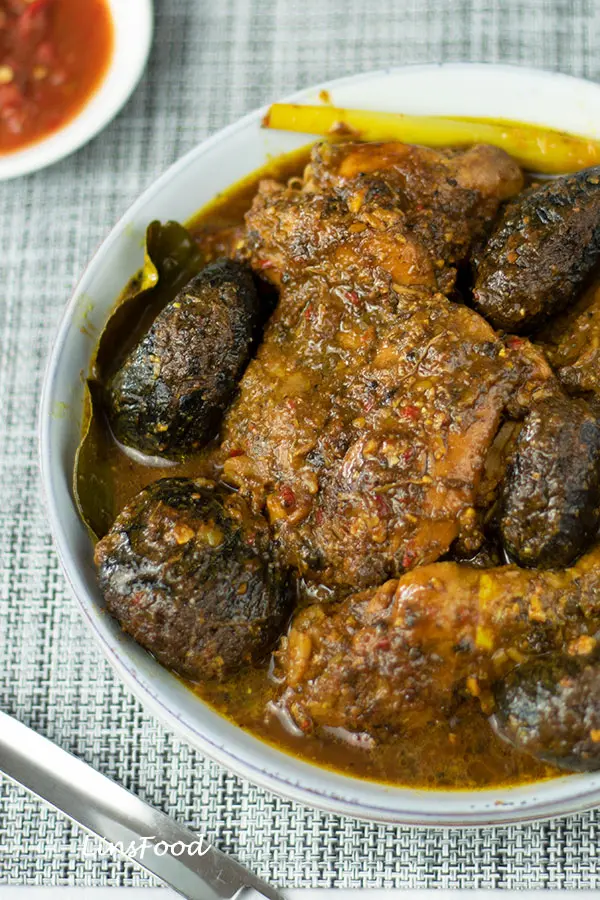
Cooking Ayam Buak Keluak
1. Soak and Scrub Buah Keluak
- Soak the buah keluak for 5 days, changing the water every day.
- On the 4th day, scrub the buah keluak, then top with fresh water and soak for the last day. This is optional, but I like to do it to ensure none of the ash hangs about.
- After 5 days, scrub the buah keluak again with a stiff vegetable brush. It takes me about 30 – 45 seconds per seed.
2. Lightly Marinate the Chicken
All we do is rub some turmeric powder with a pinch of salt and leave while we get on with everything else.
3. Make the Spice Paste (Rempah)
This is a simple case of grinding everything down in a chopper, or with pestle and mortar, if that’s your thing.
Reserve the chopper for the next step, with 1 Tbsp of the paste.
4. Buah Keluak Filling
This is the most painstaking and time consuming part of the recipe. I’ll have a video of this that will be up withing a few days of this article being published. Here’s what we’ll be doing:
- Tap and break the lip of each buah keluak with a pestle. Some people use a pair of scissors or cutting pliers (side cutters). But I prefer cracking the lip with a pestle.
Using the back of a small fork or teaspoon, dig out the buah keluak meat and drop it into a bowl. Or if you have a lobster pick or fork, use that. Or what works perfectly also? Knitting needle!
This takes me about 1 minute per seed. So 15 seeds, about 15 – 20 minutes? Reserve the shells. - In the same chopper you used earlier (or the mortar), mince the prawns (shrimp), chicken and buah keluak meat to get a smooth paste, along with a pinch of salt, some sugar (to counter the bitterness), lime juice and cornflour for binding.
- Now, remember the empty shells? Using the back of a small spoon or fork, stuff the prepared filling back in the shell to the brim. Smooth out the top and set aside. This will take you 20 – 30 minutes.
That’s the hard part done.
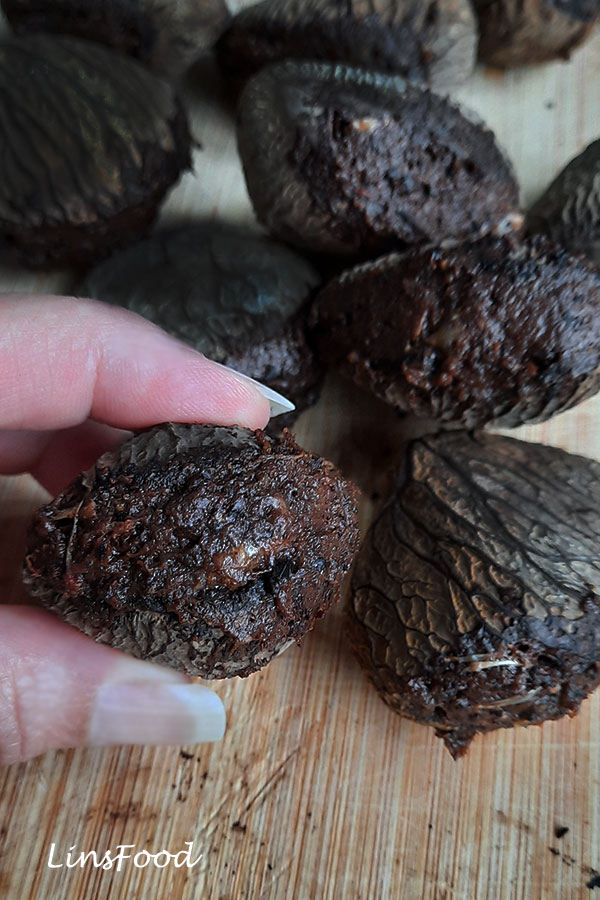
5. Cooking
The rest is going to be a walk in the park:
- Sauté the paste.
- Add chicken and coat, then add tamarind.
- Add water, stuffed buah keluak and everything else and bring to a simmer. Cook for 45-60 minutes until the chicken is done. This will depend on the size of your portions.
- At the end of cooking time, check seasoning and adjust. We are going for a rich, creamy and slightly tangy flavour with a fragrant gravy.
The Ingredients
Chicken
I have always been a fan of using chicken portions, as opposed to a whole chicken. This way, you get your favourite parts. You want a combination of meat on and off the bone. I’m using drumsticks and boneless chicken thighs.
A little bone is the way to go, as it’ll give you a richer gravy, something I’ve discussed many a time in our various curry recipes, here on SMR, as well as on LinsFood.
Buah Keluak
You can’t do without. There is no substitute for buah keluak. But as mentioned above, go with the powder, if you prefer and can get it, it’ll make the recipe easier to cook.
The number of buah keluak in a recipe is a personal thing. The more buah keluak you use, the darker your curry.
The Filling
I’m using a combination of prawns and chicken meat, minced along with the buah keluak flesh or meat. This is then seasoned and bound together with cornflour.
You could leave the prawn and chicken out, and just pound the buah keluak and season it, as some families do.
The Spice Paste
This is just a matter of grinding everything up, starting with the harder ingredients, giving them more time to be processed. Having said that, I always add a quarter onion at the start, and as the paste gets dry, to add moisture, so we don’t have to add any water.
These are the ingredients that make up our spice paste, and their corresponding Malay names (by popular demand).
Onions (Bawang Besar)
I’m using the white/brown variety. Many use the red ones, but I don’t like cooking with them. You can also use shallots, which is why I’ve given a corresponding weight in the recipe card below.
Red Chillies (Chilli Merah)
I’m using fresh ones. The chillies are only a bit player here, so there is no need to use the dried variety for their depth. You can use a hotter variety if you want your ayam buah keluak a little pedas (spicy).
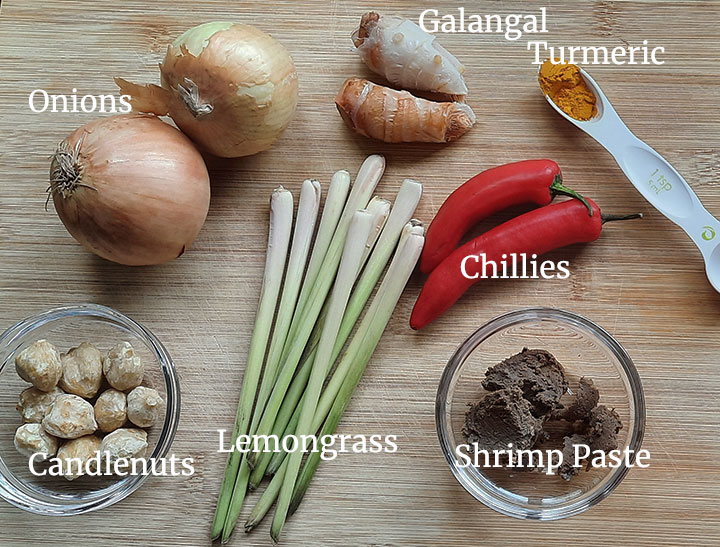
Galangal (Lengkuas)
You can read more about galangal here. There is no substitute for galangal, try and get it if you can. The paste in jars and powdered form is easily available in our supermarkets in the UK.
If you can’t get galangal, you can still cook this Peranakan dish, it will still be tasty, but perhaps missing just a little bit of the puzzle, as we are using quite a lot of galangal.
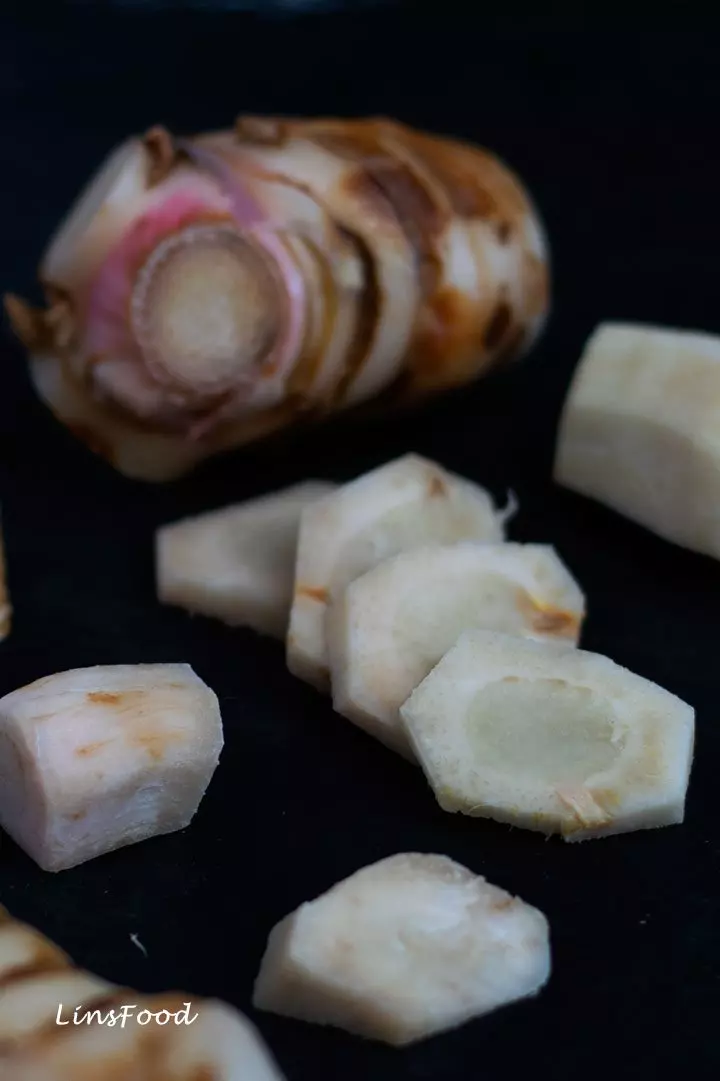
Lemongrass (Serai)
You can read more about lemongrass here, and how to prepare it for the various ways it’s meant to be used. You want good sized lemongrass stalks. I have rather thin ones here, so I’ve increased the number.
Lemongrass is a pretty common ingredient in many parts of the world these days, I think, no?
Turmeric (Kunyit)
The traditional way would be fresh turmeric. Now I can easily get it in Waitrose and with Ocado here in the UK, but I thought I’d simplify it for you guys and go with the powder (serbuk kunyit).
Shrimp Paste (Belacan)
Read more about shrimp paste here and for substitutes. Again, found in UK supermarkets and any East Asian store. Its Thai name is kapi.
Candlenuts (Buah Keras, Kukui Nuts)
You can read more about candlenuts here. They add richness to spice pastes, and therefore, whatever dishes they are used in.
This is the other pesky ingredient for some. Good news is macadamia nuts are the perfect substitute, if a little expensive.
The next best thing? Cashew nuts, but always use about half the amount as cashews are creamier.
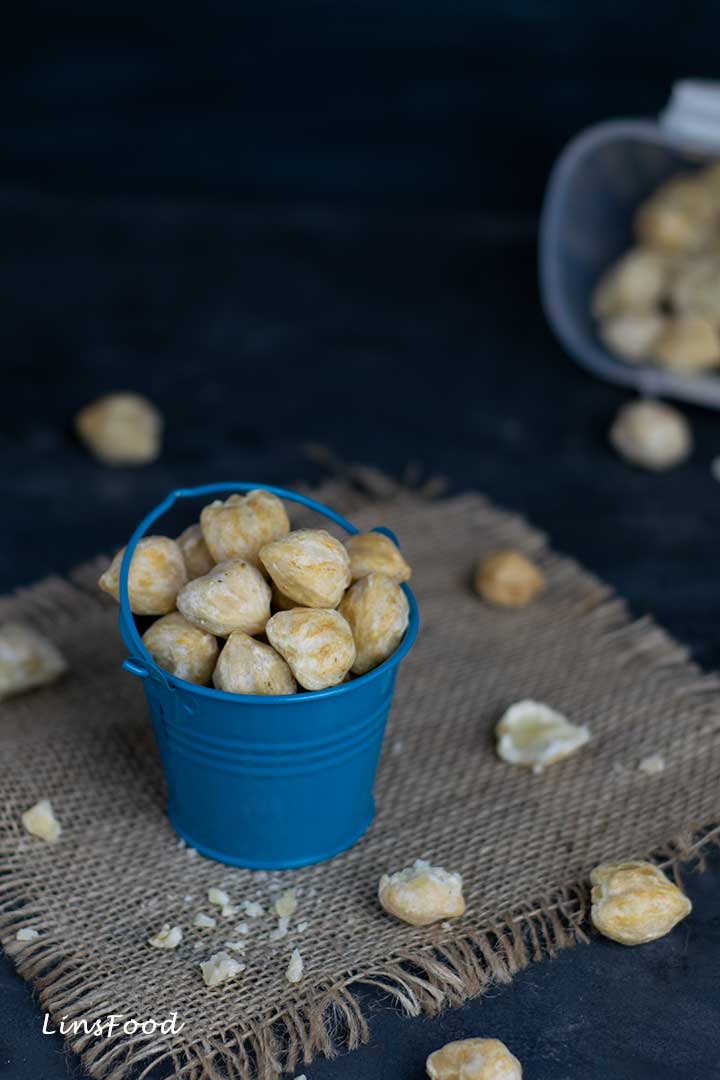
Tamarind (Asam Jawa)
You can read more about tamarind here, its substitutes, and how to prepare it. Ayam buah keluak has a definite tangy flavour, but not overly so. This is provided by the tamarind we use.
I think tamarind is also a fairly common ingredient in many parts of the world. But if you can’t get it? The simple clear vinegar will do.
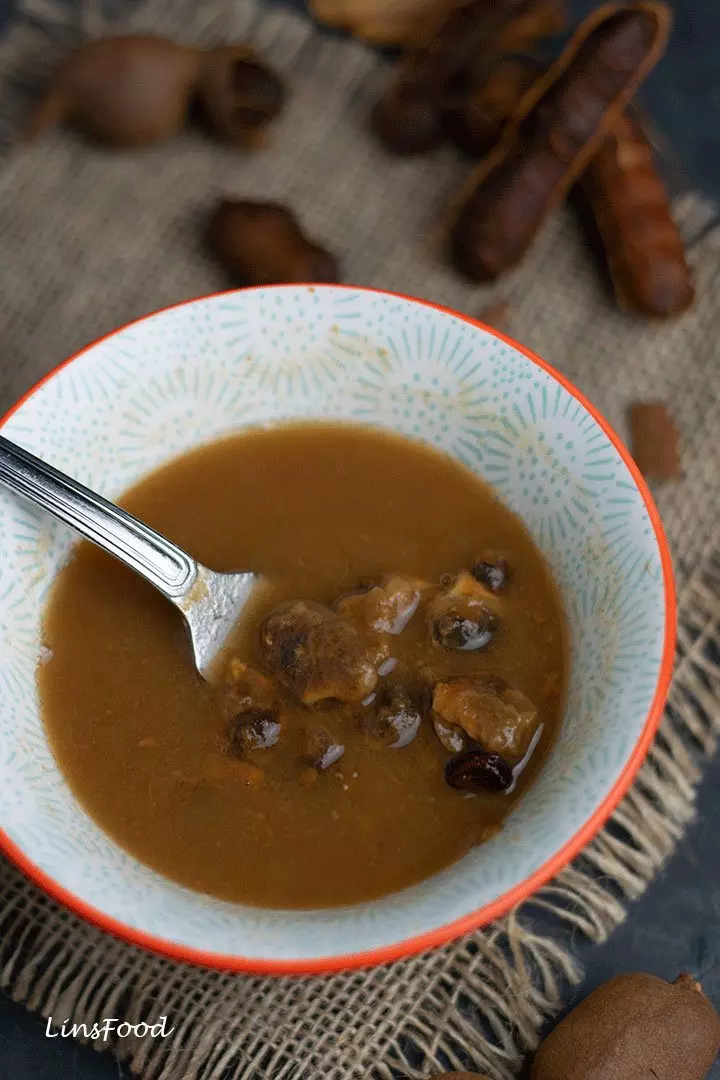
Kaffir Lime Leaves (Daun Limau Purut)
These are purely optional. If you have access to them, great. If not leave them out. And no need to finish our ayam buak keluak with any herb.
I love adding kaffir lime leaves to this recipe because, I grow my own, and my plant has always been a monster, it grows faster than I can use the leaves! But more importantly, they add to the aroma of this very fragrant dish.
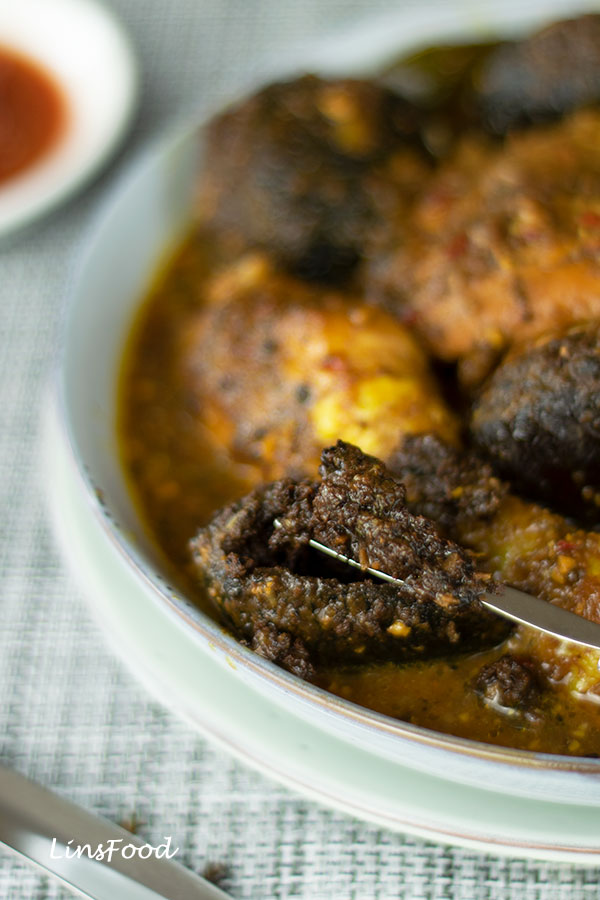
How to Serve Ayam Buah Keluak?
It’s best served with white rice, and as part of a meal. A little sambal belacan on the side is also a must because what’s Peranakan food, nope, what’s life, without sambal?
To enjoy the buah keluak themselves, you’ll need to pick the filling with your fork, literally digging in. Or do like the locals do and use your fingers.
In the image here, you can see that I have a simple beansprout (taugeh) stirfry, perfect with our rich Nyonya dish.
Here are some examples of other side dishes to serve alongside ayam buak keluak.
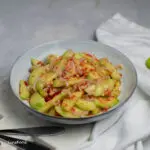
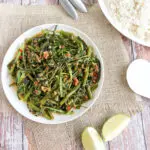
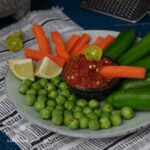
How long will it Last?
Ayam buah keluak will keep in the fridge for 2 days. In fact, it tastes better the next day. It can also be frozen on the day of cooking.
Reheat thoroughly before serving.
And there you have it – everything you wanted to know (and didn’t!), to cook ayam buak keluak. I’m sure I feel a repetitive strain injury coming on after all that typing!
Shall we get cooking?
If you enjoy the recipe, drop me a comment and let me know. And if you are feeling like a star, don’t forget that 5-star rating!
If you make this recipe, post it on Instagram and tag me @azlinbloor and hashtag it #linsfood.
Lin xx
More Nyonya Recipes
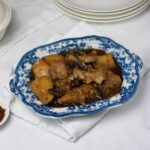
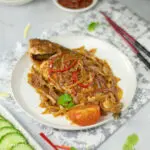
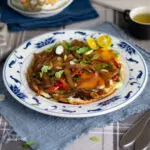
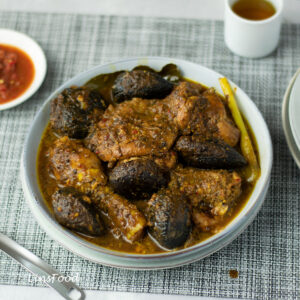
Ayam Buah Keluak (a Nyonya Recipe)
Equipment
- knife and chopping board
- a large bowl
- 1 side plate for weighing down buah keluak
- 2 small bowls
- 1 food chopper/processor OR PESTLE AND MORTAR
- large saucepan or Dutch oven
- ladle
- cutlery as needed
Ingredients
Buak Keluak and Filling
- 15-20 buak keluak
- 60 g prawns (shrimp)
- 60 g chicken meat
- 1 pinch salt
- 1 tsp white sugar
- 1 Tbsp lime juice
- ½ Tbsp cornflour (cornstarch)
Spice Paste (Rempah)
- 2 medium onions about 260g/9oz pre peeled weight
- 10 candlenuts
- 12.5 cm galangal about 90g/3oz pre peeled weight
- 6 stalks lemongrass about 120g/4oz pre cut weight
- 2 mild long red chillies
- 1½ Tbsp shrimp paste
- ½ tsp ground turmeric
Everything Else
- 1 kg chicken portion some on the bone, but no more than half
- ¼ tsp ground turmeric
- 1 tsp salt
- 2 stalks lemongrass
- 3 Tbsp vegetable oil
- 5 Tbsp tamarind pulp or 5 Tbsp shop bought paste
- 250 ml hot water for the tamarind pulp
- 1 tsp sugar
- 500 ml water or 750 ml / 3 cups if using shop bought tamarind
- 8 kaffir lime leaves optional
Instructions
5 Days Before
- Soak the buah keluak in room temperature water for 5 days. Change the water every day. Place a side plate over the buah keluak to hold them down, as they'll float to the top otherwise.
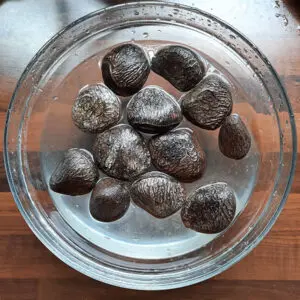
On the 4th Day (Optional)
- Drain the buah keluak, and brush them all over with a stiff vegetable brush. Rinse, top with water, and leave to soak another day.

Cooking Day
- Drain the buah keluak, and brush them again, getting rid of any sign of ash, which will be a lighter colour. Rinse, and set aside.

Marinate the Chicken
- Sprinkle 1/4 tsp of turmeric and ¼ tsp salt all over the chicken and rub in well. Cover and set aside until needed.
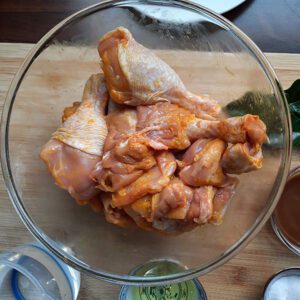
Spice Paste
- Peel and quarter the onion, and drop 1 quarter piece into the chopper. If using mortar, leave out the onion for now.Peel and slice the galangal and drop into the chopper.Top and tail the lemongrass and slice thinly, and drop into the chopper.Slice the chillies and also add them to the chopper.
- With the back of a knife, lightly bash down on the candlenuts to halve them. Place in the food chopper or mortar, whatever you're using.Process these ingredients to get a rough blend.If using pestle and mortar, pound each ingredient before adding the next one.
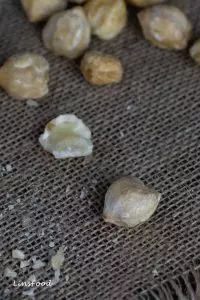
- Now add the onions, shrimp paste and turmeric and process or pound until you get a fairly fine paste.Tip out most of it into a bowl, leaving about 1 Tbsp in the chopper for the filling.

Prepping the Tamarind
- Place the tamarind in a bowl and top with the hot water. Leave to soak while you pick the buah keluak.When ready to use, just strain the tamarind straight into the saucepan using a medium mesh strainer.

Picking the Buah Keluak
- Grab a buah keluak and anchor it on a chopping board. With your pestle, pound down on the lip to crack it.Peel out the cracked pieces, then turn it upside down on the board and tap a couple of times to get rid of any loose pieces of shell.The first time you do this, go easy. By the 3rd or 4th seed, you'll get the hang of it and know just how much force to use, so as not to crack the whole shell wide open.

- Using the end of a small spoon, a lobster pick or knitting needle, pick out the buah keluak meat and drop it into a bowl.Repeat with the rest of the buah keluak. Be sure to reserve the shells.
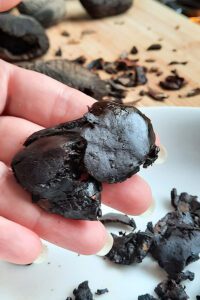
Filling the Buah Keluak
- Now we make the filling. Place the buah keluak flesh (meat) that you've picked into the chopper/mortar that should have a little spice paste in. Add the prawns, chicken meat, salt, sugar, lime juice and cornflour and process to get a fine, sticky mixture.Tip out into a bowl, or work out of the food chopper/mortar.

- Now, using the back of the smallest teaspoon you have, pick the filling and fill your empty shells with it to the brim. Flatten out, set aside. Repeat with all the shells.If you have any of the filling left over, you have 2 choices:1. Add it to the whole dish when we add the buah keluak.2. Freeze it to add to stir fries or for making Nasi Goreng Buah Keluak (coming soon).

Let's Get Cooking
- Top and tail the last 2 lemongrass and bruise them. Click here to read more on how to prep lemongrass.

- Heat the oil in a large saucepan on medium heat and fry the spice paste and lemongrass stalks for 4 minutes, until you get a strong, aromatic smell off it.

- Add the chicken, stir to coat the portions with the spice paste. Now add the tamarind and stir.
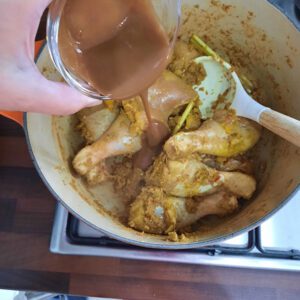
- Tip in the stuffed buah keluak, water, sugar and 6 of the kaffir lime leaves. Hold back on the salt. Bring to a boil.Then reduce the heat down to low, cover, and simmer for 45 minutes to an hour, depending on the size of the chicken portions. Basically, until your chicken is cooked.
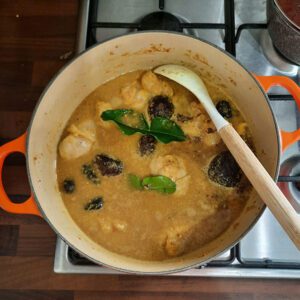
- At the end of cooking time, taste your ayam buah keluak. Add some salt if necessary, and a little more tamarind, if needed. If you don't like the little bit of bitter, add a tsp of sugar. If it's too dry, add a little water.Drop the last 2 kaffir lime leaves, stir and cook for another minute.Take off the heat, and rest for 10 minutes before serving.


6 thoughts on “Ayam Buah Keluak (a Nyonya Recipe)”